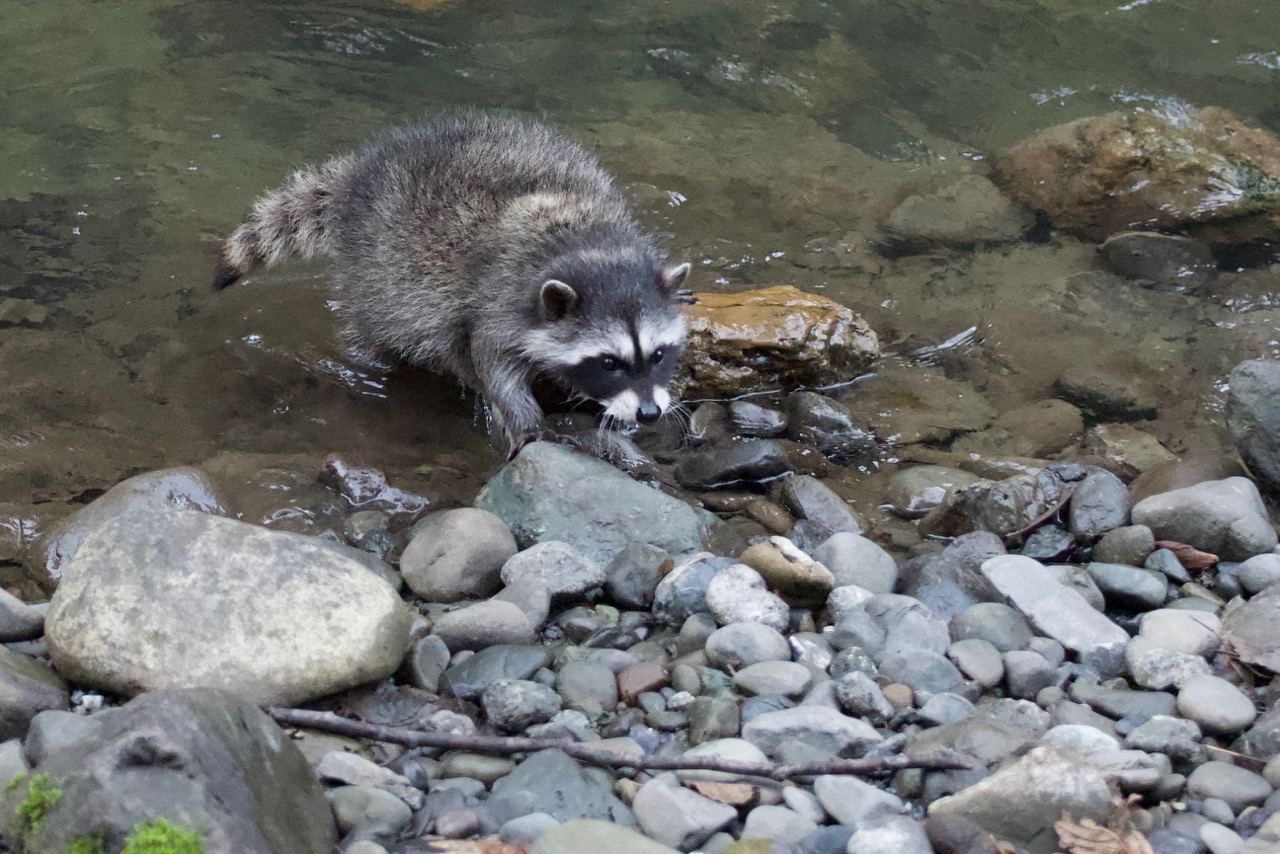
The last orphaned Raccoons (Procyon lotor) treated at Humboldt Wildlife Care Center were released on New Year’s Eve, ensuring that these youngsters returned to wild freedom before the ball fell on the year… (note: there is no evidence that raccoons care even a little bit about calendars or clocks).
Both raccoons were late season babies in a year that saw significant departures from our normal caseload – a huge increase in mammal babies as well as an extended season that lasted over a month longer than past years.
One raccoon, a female, was brought to us in early October, weighing only 450 grams, very skinny, with an infection that left both of her eyes crusted shut and heavy congestion. She was only about 4 weeks old, with teeth just beginning to emerge. Her first day in care was nearly her last due to the severity of her condition. She’d been alone for many days after her mother and siblings had been illegally trapped. Severely dehydrated and malnourished, still she showed remarkable strength. She responded quickly to the antibiotics we gave her. The fluids and milk replacer also did their part. Soon she was in good body condition, well hydrated and full of spitting fury.
Our concern that she would be alone for most of her care was alleviated when we admitted another raccoon at the beginning of December. This one, a male, was the same size and at the same stage of development as our female orphan. He was brought to us after being found lingering at the back door of a restaurant, where some were feeding him scraps.
Both raccoons were served by the other’s company. Having a buddy, if you’re a raccoon too young to be on your own, helps reduce stress and promotes well being – play is critical for learning. Raccoons playing together learn about the natural diet items that we provide and playing together encourages them to eat. Play is critical for developing physical skills like climbing. While we don’t wish for patients, admitting the male in early December really helped the female, and having the female in care already was a boon to the male, once his quarantine was over.
We check the weights and development of our orphaned raccoons every two weeks, striking a balance between our need to monitor their progress and their need for privacy and the protection of their wild hearts. By mid-December, we knew that their next check-up would be on New Year’s Eve and we knew that they were likely to be ready to go at that time. When the day arrived, both raccoons passed their release evaluation and were taken to a very nice spot for a young raccoon to enter the Wild, a place remote from human houses, in a healthy ecosystem with a lot of excellent food.
 Evaluation for release includes behavior such as wild food recognition and fear of people, physically, each raccoon must be in good health and fully functional, and a weight check – raccoons must be a certain size before they can considered for release.
Evaluation for release includes behavior such as wild food recognition and fear of people, physically, each raccoon must be in good health and fully functional, and a weight check – raccoons must be a certain size before they can considered for release.



 In our raccoon housing, we have an artificial river which we use to help them learn that fish and other aquatic creatures are delicious and found in water. When taken to a real river, they know what to do!
In our raccoon housing, we have an artificial river which we use to help them learn that fish and other aquatic creatures are delicious and found in water. When taken to a real river, they know what to do!
 Exploring the new world takes time… both raccoons exhibited a very cautious approach after they came out of their carriers. Studies have shown that wild animals who approach novel situations with caution and even fear, do better at avoiding the dangers of the human-built world. Protecting the wildness of our patients is as important as treating their injuries.
Exploring the new world takes time… both raccoons exhibited a very cautious approach after they came out of their carriers. Studies have shown that wild animals who approach novel situations with caution and even fear, do better at avoiding the dangers of the human-built world. Protecting the wildness of our patients is as important as treating their injuries.

 Our last glimpse of these raccoons before they left for the surrounding Wild… and excellent way to close out the year!
Our last glimpse of these raccoons before they left for the surrounding Wild… and excellent way to close out the year!
Caring for raccoons is challenging and rewarding. Raccoons are very intelligent and seek mental stimulation. Keeping them wild and fearful of humans is difficult – they’re smart enough to read our actions. So we adopt a hands off approach once they are weaned. Our housing is designed to be a teacher – a safe place to explore an imitation wild environment, complete with moving water, grasses, hidden insects, eggs, prey items, and fruits (mostly zucchini!) that we put in branches they must climb to reach. We’re proud of the raccoons who graduate from our school! And we’re grateful to all who support our work and make our raccoon program the success that it is!
Now our raccoon housing is empty, which gives us the needed time to make repairs and improvements for our next season which is only four months away! Want to help us out? Donate today! Thank you!!


